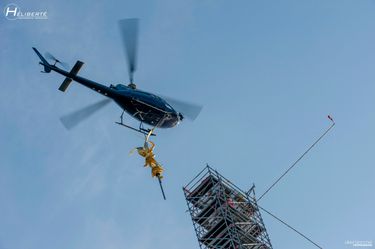Summary
- After undergoing months of restoration work, the beloved archangel of Mont-Saint-Michel cathedral fo

It was only 8:45 a.m. on May 26, but already dozens of people carrying cameras and smartphones were gathered on the famous island of Mont Saint-Michel in Normandy, France. There was an air of excitement and curiosity among the assembled tourists, pilgrims and locals. After an absence of two and a half months for restoration work in France’s Dordogne region, the archangel of Mont Saint-Michel was coming back home.
Clad in over five ounces of gold, the archangel flew over the area, suspended from an Écureuil AS350 BA helicopter piloted by Frédéric L’Horset, who steered it to the abbey’s pinnacle 525 feet above sea level.
The crowd burst into applause. The mission was a success, carried out by one of French helicopter operator Héliberté’s star pilots.
Nevertheless, it was one of the most delicate operations of his career. “Actually it was one of our most difficult missions because we had no visual reference,” says seasoned L’Horset, who has 16 years of flight experience. “We approached the task by installing poles with flags extending off the top of the Mont Saint-Michel abbey to give me a point of reference and guide me without any glitches.”
Mission accomplished
L’Horset makes clear that he did not use the rearview mirrors during the mission to transport the 15-foot, 1080-pound statue, but only looked at the pole to his right as a guide, and also followed the instructions of Laurent Betton, Héliberté’s CEO.
“You are a little too high, too low, go forward, go back a little.” That was how Betton provided the pilot with valuable directions while he maneuvered the AS350 BA, which can carry a load of up to 700 kg.
Betton’s guidance coupled with ideal weather (a 12.5 miles/hour linear wind) made it possible to conduct the operation in “one shot,” says the pilot, proud of his accomplishment.
But actually the initial operation in March to remove the archangel of Mont Saint-Michel for restoration was even more complicated.
“We requested that a pole be mounted at the edge of the archangel to maintain our position,” explains L’Horset, “but we were told that this was basically and technically not feasible. I needed two tries to approach the platform. The statue looked so small from above and I could not see it in my rearview mirror. So I pushed again for a pole to be mounted, which was finally granted. It only took a few minutes to install and enabled me to retrieve the archangel, which is mounted on a ten-foot metal stake that attaches to its pedestal on the top of Mont Saint-Michel.”
“That was difficult. The location was quite narrow. Once the archangel was attached, I started to pull away to gain height and lift it up in a straight position. Then I just had to carry the archangel to the designated area and deposit it in a pipe for its trip to the Dordogne. Everything went smoothly,” says the pilot, recalling this happy ending.
Héliberté, a dream that became reality
Héliberté CEO Laurent Betton is as enthusiastic as his colleague when he talks about this mission.
He feels it was the most interesting and difficult operation in the company’s history, which he has led for over six years. Other missions by Héliberté include transporting heavy loads, aerial photography for films, transporting VIPs, sightseeing, monitoring electrical and gas utility networks. He uses a fleet of seven Écureuils (Squirrels), including the AS350 BA, which performed the Mont Saint-Michel mission.
“We had an excellent team on site at Mont Saint-Michel. The mission was fascinating, especially because of its history,” he said, alluding to the fact that the archangel had been installed on the abbey of Mont Saint-Michel in 1897 and has only been restored twice since then. Plus, the abbey is also a UNESCO World Heritage site. The archangel’s return to the abbey was an event covered by the world’s media, and LBetton knew the team could not fail.
“Héliberté was built on a passion that I had as a child, which was difficult to make a reality because the helicopter world is very small. To realize my dream, we had to start from scratch. But — and I stress — we did it through dedication and hard work,” he says.
And it is true that today his dream is a reality. The Héliberté fleet logs some 1,500 to 2,000 flight hours per year. The company has seven bases in France: Dinan-Saint Malo, La Rochelle, Le Mans, Vannes-La Trinité, La Baule-Nantes, Amboise-Blois and Royan-Arcachon.
“It is very rewarding to help people discover the world of helicopters through our routes. When they leave the aircraft after a flight, they are all smiling ear to ear,” he says with satisfaction.
Safety and trust
The operator uses its own maintenance shop and highly certified mechanics. Betton’s top priority is safety, as is helicopter maintenance, both part and parcel of the company’s commitment to professional standards, quality and accident prevention.
Héliberté has big growth plans for the future. The company has purchased new aircraft so it can handle all requests and offer the best equipment for every mission. And they are doing all this while hard at work — transporting French passengers, tourists and even angels through the air!


